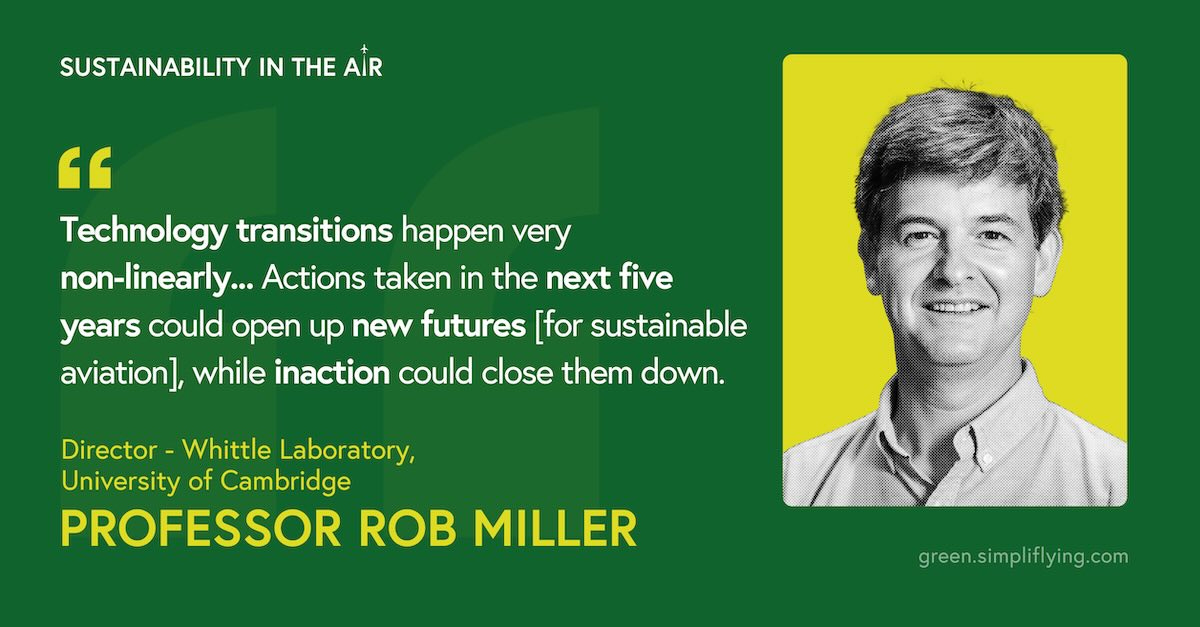In this episode of ‘Sustainability in the Air’ podcast, Professor Robert Miller, Director of the Whittle Laboratory at the University of Cambridge, speaks with SimpliFlying’s CEO Shashank Nigam about the urgent need for accelerated action in sustainable aviation. Miller is also the head of the Aviation Impact Accelerator (AIA), a collaboration between the Whittle Laboratory and the Cambridge Institute for Sustainability Leadership.
The AIA recently released the “Five Years to Chart a New Future for Aviation” report which outlined four key Sustainable Aviation Goals. If achieved in the next five years, these goals can help the aviation industry reach net zero by 2050. The report was developed following a collaborative workshop at MIT, with key stakeholders including NASA, the Federal Aviation Administration, EU Clean Aviation, and UK government departments.
The report presents three detailed scenarios showing different routes to net-zero aviation by 2050:
Scenario 1 (Current Trajectory): Shows how current ambitious targets for SAF production, without implementing the 2030 Goals, fail to achieve net zero by 2050.
Scenario 2 (Moonshots Success): Details how successful hydrogen technology deployment combined with Operation Blue Skies could achieve net zero while reducing biomass dependence.
Scenario 3 (Efficiency and SAF): Demonstrates how aggressive efficiency measures combined with sustainable SAF deployment could achieve net zero even if moonshot technologies prove unviable.
Here are the key highlights of the conversation:
Understanding technology transitions and tipping points (2:55)
Operation Blue Skies: Tackling contrail emissions (11:30)
Bold measures for fuel efficiency (18:10)
Sustainable Aviation Fuel challenges (30:25)
Moonshot technologies (38:25)
Future scenarios and pathways (45:45)
Rapid Fire! (48:20)
Keep reading for a detailed overview of the episode.
Why focusing on 2030 goals matters for aviation
The aviation sector faces a critical challenge – while only about 10% of the global population has ever flown, aviation already accounts for around 2.5% of global CO2 emissions and approximately 4% when including non-CO2 effects.
Conventional industry roadmaps for sustainable transitions are often depicted using ‘wedge charts’ showing gradual transitions towards more sustainable technologies. Miller argues that such depictions can be inaccurate and misleading for two reasons:
Only one technology usually becomes dominant in the end, with perhaps a marginal second, as seen with VHS over Betamax or cars over horses.
Technology transitions occur in a non-linear and unpredictable manner.
The AIA’s report suggests that current efforts, despite ambitious pledges, remain dangerously off track. Without swift and decisive action by 2030, the opportunity for transformation will slip away as aviation is projected to at least double by 2050. The report emphasises that proposed solutions like heavy reliance on biomass for jet fuel without managing environmental impact could potentially exacerbate the crisis.
The urgency of the 2030 targets is further underscored by the need to expand aviation accessibility. “Only 10% of the world has ever flown,” Miller notes. “We’ve got all these people – the new rising middle class in Asia, Africa, South America – who want to take their first flight, and they have a right to take that first flight.”
The four key 2030 sustainable aviation goals
1. Revolutionising contrail management through Operation Blue Skies
The first goal identified in the Five Years to Chart a New Future for Aviation is to address a significant but often overlooked contributor to aviation’s climate impact – persistent contrails.
Miller explains that about 1 in 20 flights produces persistent contrails with substantial warming effects: “One in 20 flights does about the same climate damage in that 6-12 hour period, we think in terms of warming, as all 20 flights’ CO2 does over 100 years.”
While the scale of impact of contrails is known to be significant, its precise magnitude remains uncertain. Avoiding contrails calls for an adjustment in altitude, as Miller describes: “The areas [where contrails form], the ice supersaturated regions in the sky are like pancakes. And therefore, if you’re in one, you need to change altitude up or down so that you stop forming that contrail.”
The report proposes establishing “Airspace-Scale Living Labs” to address multiple systemic uncertainties in contrail prediction, including air traffic control systems, flight planning, weather modelling, and operational coordination. Miller outlines four essential requirements for these living labs:
The report also sets out an ambitious timeline: if these living labs are established immediately and completed by 2030, the global rollout of contrail avoidance measures could begin that same year.
2. Transformative measures for fuel efficiency
The report also outlines specific bold measures that could halve fuel burn by 2050, going far beyond the 20% reduction projected from conventional efficiency improvements.
Miller explains three key approaches:
Accelerated fleet replacement: “If [aircraft production] is tripled, instead of being doubled, as projected by aircraft manufacturers… then that would effectively halve aircraft life. So it would take aircraft life down from about 30 years to about 15 years,” explains Miller.
Designing aircraft to fly slower: “If you fly at about Mach 0.72, [which is] about a 15% slower speed, you can reduce fuel by 5-7%.” While this adds approximately 50 minutes to transatlantic flights, Miller notes changing public attitudes: “The public is feeling guilty quite often about flying. And I think people will accept the extra time if they can keep on travelling.”
Better matching aircraft to routes: Ensuring more aircraft operate close to their design range by introducing new aircraft types and optimising purchasing and operating practices.
According to the AIA report, the addition of these measures to the conventional efficiency improvement practices is projected to achieve a cumulative 31% to 50% reduction in emissions by 2050.
3. The complex landscape of sustainable aviation fuel
The report stresses the need for “truly sustainable and scalable sustainable aviation fuels (SAF)” and points out the challenges involved in scaling them up. Miller identifies a key limitation in current SAF policy: the finite supply of global biomass, which is estimated to be between 50 and 160 exajoules (EJ).
“When you account for the climate impact of the resource that’s taken from other sectors and you add it into the system, you find that in some scenarios, transitioning to SAFs can make the problem worse.”
Miller outlines three specific approaches to make SAF truly sustainable:
Carbon-efficient production routes: Miller states that Power-and-Biomass-to-Liquid (PBtL) fuels offer superior carbon efficiency. This process upgrades carbon content with green hydrogen and electricity, requiring significantly less biomass than traditional methods. In contrast, conventional Biomass-to-Liquid processes must store or release about two-thirds of carbon underground, making them less efficient.
Carbon capture integration: While less carbon-efficient directly, Biomass-to-Liquid fuels can achieve negative emissions through carbon capture and storage (CCS), potentially offsetting induced emissions in other sectors. However, this requires substantial infrastructure investment and careful monitoring.
Strategic sector coordination: The report proposes co-locating SAF production with other industrial facilities. For example, integrating with coal power stations allows biomass to replace coal while capturing carbon dioxide for SAF production, reducing emissions across both sectors, says Miller.
The report also highlights significant variations in ticket prices based on different SAF technologies. According to Miller, Biomass-to-Liquid could increase prices by 30%, Power-and-Biomass-to-Liquid by 60%, and Power-to-Liquid by 80-90%. Another key concern is aviation’s ability to compete with other sectors for limited biomass resources.
Moreover, the infrastructure needed for SAF production is also considerable. PBtL production alone could require 9-16% of the world’s planned low-carbon grid capacity by 2050. The report calls for policy changes to optimise biomass allocation across sectors, ensure aviation develops its own renewable electricity supply, and establish clear transition plans for early SAF plants to achieve full sustainability by the 2040s.
4. Pioneering future technologies
The report identifies several promising “moonshot technologies” that could transform aviation, similar to the way Tesla revolutionised the automotive sector. These include cryogenic hydrogen, cryogenic methane, synthetic biology, and hybrid electric propulsion. Of these technologies, hydrogen shows particular promise for long-range aviation due to its physical properties.
“Even when the cryogenic tanks that store hydrogen at -253° C are included, it’s half the weight of jet fuel,” Miller explains.
The report estimates that hydrogen-powered aircraft could achieve 10% lower energy consumption per passenger kilometre on long-haul flights. An additional 10% efficiency gain is possible by harnessing energy stored during the hydrogen liquefaction process.
The report outlines three essential hydrogen demonstrator programmes required by 2030:
The report estimates that delivering these moonshot demonstrators by 2030 will be challenging but achievable, requiring focused effort from either international coalitions or large countries.
However, infrastructure planning is critical, with the flights departing from around 50 of the world’s largest hub airports consuming approximately half of global jet fuel. For example, London Heathrow Airport would require 1.6 GW to power on-site hydrogen liquefaction, equivalent to a large UK power station.
Multiple pathways to net zero
The AIA’s sophisticated modelling reveals multiple potential paths to net-zero aviation by 2050.
“There is not just one solution through the maze,” Miller explains. The key lies in maintaining flexibility while taking decisive action. “You could reach a point in 2030 where all the moonshots fail, and you could go really hard on truly sustainable SAF and systems efficiency... Or if a moonshot comes through – the methane or the synthetic biology or the hydrogen – again, there are other scenarios through the maze.”
This multi-pathway approach, combined with sophisticated monitoring and policy adaptation, offers hope for achieving aviation’s sustainability goals while expanding access to air travel globally. The success of this transition will depend on continued collaboration between industry, academia, and policymakers, along with sustained investment in both proven solutions and promising new technologies.
‘Sustainability in the Air’ is the world’s leading podcast dedicated to sustainable aviation. Through in-depth conversations with top aviation leaders, we break through the clutter and provide a clear roadmap for a net-zero future.
















